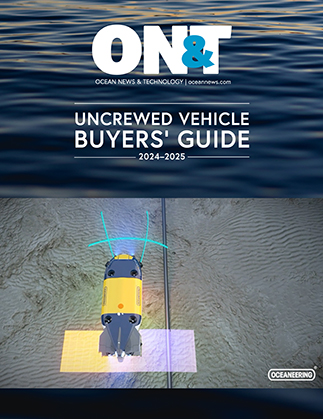A group of scientists led by the Center for Southeastern Tropical Advanced Remote Sensing (CSTARS) of the University of Miami recently published an overview of synthetic aperture radar (SAR) as a tool to identify oil slicks on the ocean surface using satellite imagery.
The researchers outlined the “capabilities and shortcomings” of SAR to identify oil slicks that enter the marine environment through seeps, leaks, illegal discharge, and other industrial, transportation, or drilling accidents. They summarized the techniques used for identifying oil with SAR, the advanced capabilities of the newer programs and instruments, and the advancing potential for SAR to be used to monitor oceans for natural and illegal spills. The team published their findings in the June 2013 issue of Oceanography: Oil Spills and Slicks Imaged by Synthetic Aperture Radar.
SAR, an “active microwave high-spatial resolution sensor,” uses roughness to yield a complex, high-resolution map of an observed scene. Oil on the surface of water dampens wind-induced wave action and thus appears as noticeably darker patches, markedly different from the non-oiled water in SAR images.
 A colorized SAR image, taken June 8 2010 using the TerraSAR-X satellite (Infoterra GmbH), shows oil around Barataria Bay, Louisiana. The green colors are land, the blue colors are water and the red/yellow colors are oil. (Image credit: Center for Southeastern Tropical Advanced Remote Sensing)
A colorized SAR image, taken June 8 2010 using the TerraSAR-X satellite (Infoterra GmbH), shows oil around Barataria Bay, Louisiana. The green colors are land, the blue colors are water and the red/yellow colors are oil. (Image credit: Center for Southeastern Tropical Advanced Remote Sensing)
Different SAR imaging modes provide regional or local applications. ScanSAR images a larger area at a lower resolution to identify the extent of spills in the open ocean. It can locate and map sizable anomalies, such as the Deepwater Horizon incident in 2010, but cannot illuminate smaller details. Stripmap and Spotlight modes, on the other hand, have the resolution capabilities required to identify smaller amounts of discharge such as leaks emanating from ships and to see in harbors or estuaries.
When a spill is detected through this process, “imaging parameters can be customized for the type and extent of the spill” and higher resolution settings are employed if necessary. As an example, the team gives an extensive outline of how this process worked during the 2010 oil spill response, when “an unprecedented nine SAR satellites” worked together to keep track of the oil as it spread across the Gulf. A combination of high-resolution images of about 1 meter assessed oil spreading in estuaries and lower-resolution images between 10 – 100 meters monitored the wider northern Gulf.
SAR is not a perfect instrument for oil detection. Certain weather conditions, such as thunderstorms and rain, can mask the appearance of oil or produce images that look like oil. Low surface wind speeds can also make maps appear featureless or produce lookalike slicks. It can be also difficult to delineate between slicks from illegal oil discharge in the form of a drilling accident and oil from natural seeps imaged with SAR. As oil degrades, it becomes more difficult to identify using the system and over time, it becomes undetectable, especially with increased wave action. For these reasons, it is important to consider “the source of the oil, the current environmental conditions, and the history of the sea surface in localized areas” before deciding if SAR would be an appropriate detection tool.
The scientists see SAR technology continuing to advance, with improvements at satellite and ground levels. “Next-generation satellites will feature new imaging modes” and specialized filters to help operators further refine the system’s capabilities. These newer systems have automated processing algorithms to provide “region selection, feature extraction, and spill classification.” These techniques are then overseen by an expert operator trained to analyze the results. The trend is towards more detailed and specific modeling in the automation to eliminate subjective interpretation by the user. In addition, the processing algorithms are constantly being enhanced to account for weather features, etc., that might impact image results.
The constant demand for petroleum products throughout the world will inevitably result in more oil spills. SAR provides a valuable tool for routine monitoring of oil extraction and transportation for harmful leakage events. When spills are detected, it can be used to assess the extent of the damage and to guide response efforts. Finally, it provides scientists with the means to observe the behavior of oil on the surface of a large body of water.
The study’s authors are M.J. Caruso, M. Migliaccio, J.T. Hargrove, O. Garcia-Pineda, and H.C. Graber (Oceanography, 2013, 26 (2): 112-123)
This research was made possible in part by a grant from BP/The Gulf of Mexico Research Initiative (GoMRI) to the University of Miami’s Center for Southeastern Tropical Advanced Remote Sensing (CSTARS) and Rosenstiel School of Marine and Atmospheric Science for their project Monitoring of Oil Spill and Seepage Using Satellite Radars. The GoMRI is a 10-year independent research program established to study the effect, and the potential associated impact, of hydrocarbon releases on the environment and public health, as well as to develop improved spill mitigation, oil detection, characterization and remediation technologies. An independent and academic 20-member Research Board makes the funding and research direction decisions to ensure the intellectual quality, effectiveness and academic independence of the GoMRI research. All research data, findings and publications will be made publicly available. The program was established through a $500 million financial commitment from BP. For more information, visit http://gulfresearchinitiative.org/.
